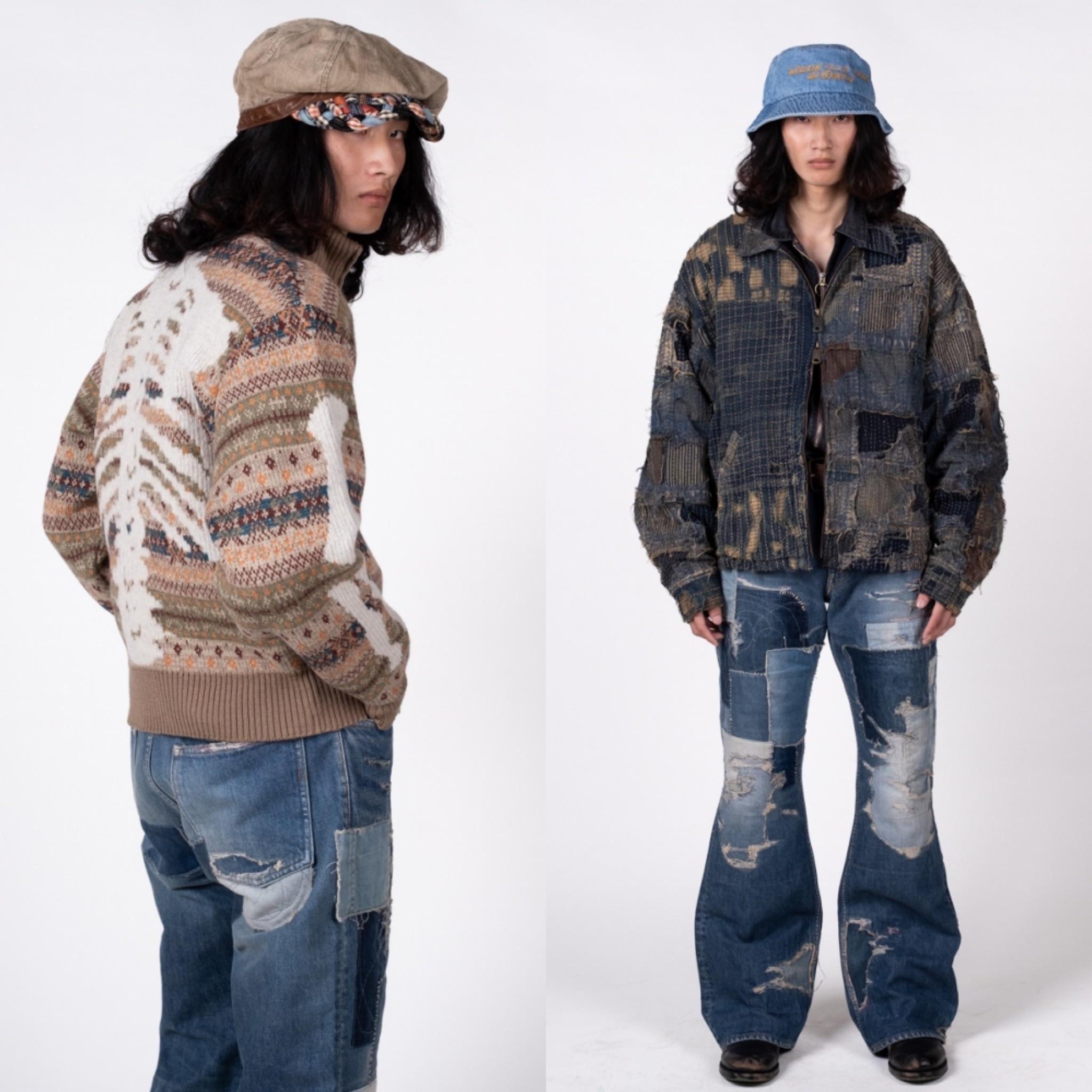Between Two Distinct Streetwear Brands

Kapital and Corteiz represent two very different corners of the fashion world. Kapital, founded in 1984 in Japan by Toshikiyo Hirata, is known for its Americana-inspired designs and traditional Japanese craftsmanship. It merges denim with native techniques like sashiko and boro stitching. In contrast, Corteiz (sometimes stylized as Crtz), launched in London in 2017 by Clint419, rose from underground street culture. Corteiz leans heavily into youth-driven rebellion and exclusivity, often using guerrilla marketing tactics. While Kapital has grown organically through heritage, Corteiz has exploded through hype and cult-like loyalty. These histories shape the brands’ aesthetics and philosophies.
Design Philosophy and Aesthetic
Kapital draws deeply from Japanese folk traditions and American workwear. Its aesthetic is eclectic, often blending whimsical elements like smiley faces with vintage fabrics and distressed denim. Every Kapital piece feels like wearable art, crafted with attention to detail. Corteiz, however, pushes boundaries through minimal but provocative streetwear. Their use of military inspiration, cryptic slogans like "Rules the World," and emphasis on political undertones give it a radical edge. While Kapital is expressive through textures and patterns, Corteiz is vocal through its branding and message. These divergent approaches attract very different customer bases in the fashion community.
Fabric and Craftsmanship
Kapital is celebrated for its high-quality materials and traditional techniques. From natural indigo dyeing to hand-stitched repairs, each item reflects Japanese craftsmanship at its finest. Denim, cotton, and wool are staples in their lineup, giving garments a tactile and durable quality. Corteiz, on the other hand, focuses on comfort and bold design. Its fabrics are more utilitarian—cotton fleece for hoodies, heavy jersey for tees, and ripstop for cargo pants. While Corteiz doesn't match Kapital in artisanal depth, it delivers solid construction suitable for streetwear. The distinction lies in Kapital's obsession with heritage versus Corteiz’s focus on street-level wearability.
Branding and Marketing Strategies
Corteiz has become a master of hype-driven marketing. Its secretive drops, password-protected website, and limited availability cultivate exclusivity and demand. Public stunts—like shutting down London streets or organizing surprise meetups—further feed the frenzy. Kapital, by contrast, lets its clothes speak for themselves. With little to no advertising, the brand relies on word-of-mouth and organic appeal among fashion aficionados. Kapital rarely indulges in direct marketing campaigns. Its growth has been slow but steady, rooted in authenticity. Corteiz’s approach is fast, viral, and reactive, whereas Kapital’s strategy is patient, intentional, and rooted in tradition.
Cultural Relevance and Global Reach
Kapital resonates most with fashion insiders, stylists, and collectors who appreciate niche Japanese fashion. Its pieces have gained traction globally, particularly in high-end boutiques and fashion editorials. Corteiz, however, speaks directly to the youth and urban communities. It has captured a grassroots following in the UK and beyond, rapidly crossing into mainstream pop culture through celebrity endorsements and collaborations. Artists like Central Cee and Stormzy have amplified its visibility. Kapital is about legacy and craftsmanship; Corteiz is about energy and disruption. Both are globally relevant, but their influence stems from entirely different cultural currents.
Pricing and Accessibility
Kapital's pricing reflects its craftsmanship, often commanding premium prices for jackets, jeans, and accessories. A Kapital denim jacket can easily cost over $600 due to its labor-intensive production. Corteiz is more accessible in theory, with hoodie prices usually ranging from $100–$150. However, the brand’s exclusivity means resale prices can skyrocket, sometimes tripling original retail costs. While Kapital is expensive because of material and design value, Corteiz’s market inflation is driven by scarcity and demand. In essence, both are hard to get, but for different reasons—Kapital due to cost and production limits, and Corteiz due to intentional rarity.
Product Range and Innovation
Kapital offers an extensive product range—jackets, jeans, shirts, accessories, and even furniture. Each season brings new interpretations of classic silhouettes with unexpected twists. There's also a narrative aspect to Kapital's releases, often themed around cultural folklore or philosophical ideas. Corteiz keeps things lean and focused: hoodies, cargo pants, t-shirts, and jackets. The innovation lies in the drops themselves rather than the products—each release becomes an event. Corteiz reinvents marketing, not necessarily clothing. Kapital innovates through fabric manipulation and detail, while Corteiz disrupts through timing and exclusivity. The former refines fashion, the latter redefines fashion culture.
Community and Brand Loyalty
Corteiz has built a fiercely loyal, almost cult-like community. Fans camp out for drops, rep the brand in music videos, and follow every move of founder Clint419. This loyalty isn’t just to the product—it’s to the brand’s attitude. Kapital fans, meanwhile, tend to be older, fashion-conscious individuals who admire the brand's depth. Kapital wearers appreciate storytelling, history, and subtlety. Corteiz fans thrive on urgency, identity, and rebellion. Each brand fosters loyalty in its own way: Kapital through respect and admiration, Corteiz through alignment with a cause. Their followers may rarely overlap, but both are deeply committed.
Influence and Collaborations
Kapital maintains a low-collaboration profile, choosing to preserve its brand identity. When collaborations do happen, they’re niche and thoughtful—like the partnership with Hysteric Glamour or heritage brands within Japan. Corteiz, on the other hand, thrives on high-impact collaborations. Its recent Nike Air Max 95 drop sent shockwaves through sneaker culture. Collaborations are central to Corteiz’s strategy—they help amplify the brand's message and broaden its reach. Kapital prioritizes internal consistency, while Corteiz uses collaborations as a megaphone. The difference illustrates their strategic paths: one stays niche and curated; the other expands through calculated, headline-making alliances.
Sustainability and Ethical Practices
Kapital places strong emphasis on sustainable practices—natural dyes, slow production cycles, and the use of organic materials are integral. Its focus on repairable garments (like patchwork and visible mending) speaks to longevity and environmental consciousness. Corteiz doesn’t advertise sustainability as a core value, though its small-batch releases naturally reduce overproduction. However, transparency around sourcing and labor remains limited. Kapital’s roots in traditional Japanese methods make sustainability a cultural and operational standard. Corteiz, being a newer and streetwear-focused brand, hasn't fully entered the sustainability discourse. The contrast highlights Kapital’s long-view ethos versus Corteiz’s momentum-driven model.
Final Verdict: Two Icons, Two Worlds
Kapital and Corteiz represent two polar approaches to fashion. Kapital is deeply rooted in craft, culture, and slow fashion. It’s a brand for the collector, the artisan, the detail-oriented dresser. Corteiz is bold, fast, and tied to social identity and movement. It’s for the streetwise, the trendsetter, the rebel. Neither brand is superior; rather, they fulfill different needs and speak to different audiences. Kapital will likely remain a timeless staple in avant-garde and heritage fashion. Corteiz, if it continues evolving, could redefine streetwear for a generation. Together, they show how diverse and dynamic modern fashion has become.


